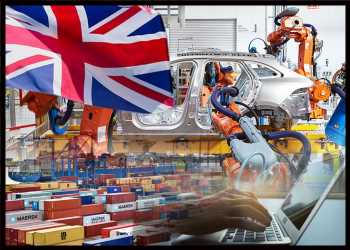The UK economy recovered at a stronger pace in the second quarter as the easing of coronavirus restrictions boosted consumer spending, the first quarterly estimates from the Office for National Statistics showed on Thursday.
Gross domestic product grew 4.8 percent sequentially in the second quarter, reversing a 1.6 percent fall in the first quarter. The rate matched economists’ expectations.
Nonetheless, the level of GDP was 4.4 percent below its pre-pandemic level.
Earlier, the Bank of England had projected the economy to grow around 5 percent in the second quarter and about 3 percent in the third quarter. GDP was forecast to reach its pre-pandemic level in the fourth quarter of 2021.
In June, GDP growth improved to 1 percent from 0.6 percent in May, ONS reported. This was faster than the economists’ forecast of 0.8 percent and marked the fifth consecutive month of growth.
The 1 percent increase in June was an impressive result given the surge in COVID-19 virus cases in that month, Ruth Gregory, an economist at Capital Economics, said.
The big picture is that the recovery so far has been faster than most imagined possible six or 12 months ago, Gregory noted. The economy may yet surprise most forecasters again by emerging from the pandemic without much scarring.
On the production-side, services continued to be the main contributor to GDP’s recovery in June 2021, growing 1.5 percent in June, following a revised 0.7 percent growth in May.
Production output fell 0.7 percent in June, as planned temporary closures for maintenance of oil field production sites once again hit output. At the same time, manufacturing output rose 0.2 percent, after rising 0.1 percent in May.
Construction output contracted for a third consecutive month, with output down by 1.3 percent in June.
The expenditure-side breakdown showed that all main components except trade contributed to the growth, with the biggest contribution from household consumption. Household spending moved up 7.3 percent and government expenditure grew 6.1 percent.
Gross fixed capital formation contracted 0.5 percent due to a sharp fall in government investment. Business investment increased 2.4 percent, though it was still 15.3 percent below its pre-pandemic levels.
Total change in inventories rose by GBP 87 million in the second quarter.
Another report from the ONS showed that the visible trade gap widened to GBP 11.98 billion in June from GBP 9.6 billion in May. At the same time, the trade in services logged a surplus of GBP 9.47 billion, slightly up from GBP 9.44 billion in the prior month.
As a result, total trade balance posted a shortfall of GBP 2.5 billion in June versus -GBP 163 million a month ago.
Source: Read Full Article
